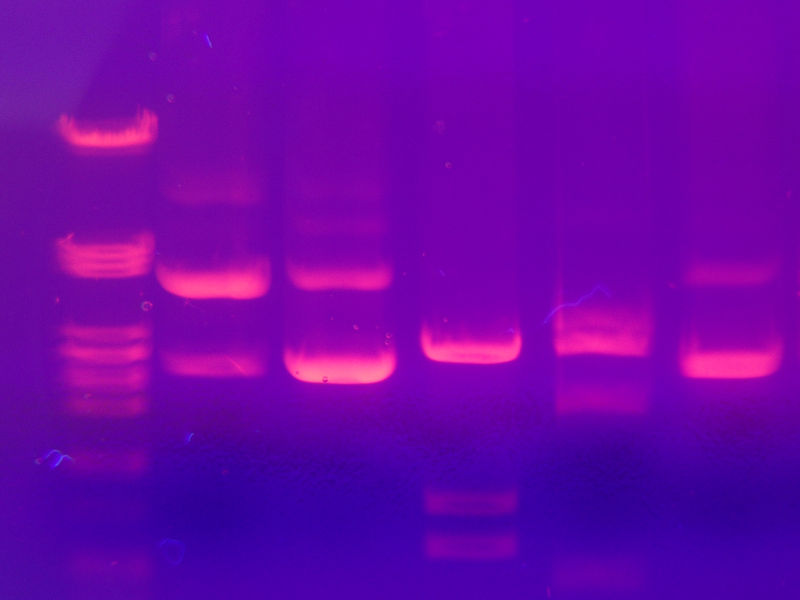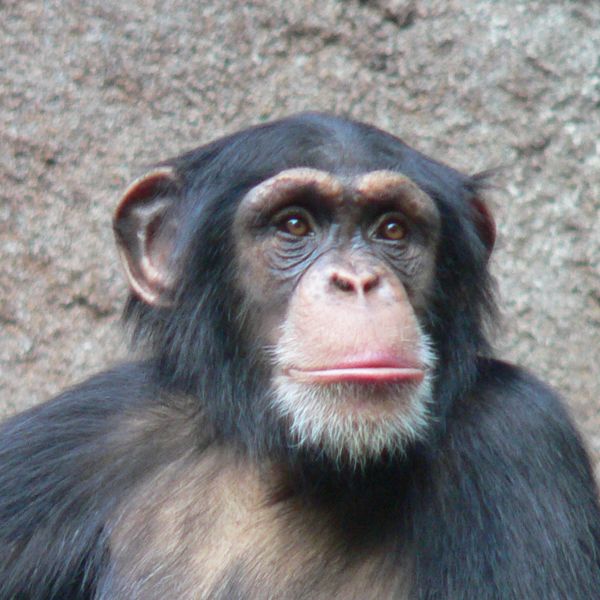The DNA that makes us Human
Interview with
Chris - Also this week, scientists at Stanford University in California have discovered how certain changes in our DNA have sculpted the evolution of human specific traits and those in particular that set us apart from our closest relatives. Dr. David Kingsley is the co-author on the work which is published this week in the journal Nature. Hello, David.
David - Hello there.
Chris - Thank you for joining us on the Naked Scientists. Could you tell us David, first of all, what was the approach? How did you try to work out genetically, how we have changed in such a way that we can do what we can do, whereas animals like chimpanzees are still hanging around in trees?
 David - One of the big breakthroughs now is that we have the complete genome sequence of both ourselves and many of our closest relatives. So the starting point for this research was to line up all the letters in the human genome with the letters in related organisms, and then look for places where the human sequence was different. That's been done before. People have looked for cases where individual letters had changed in the human sequence. This study took a different approach. We looked for block sub-sequences that were completely missing from the human genome, although present in chimpanzees, and highly conserved across many other organisms. So the fact that they're present in the highly conserved means they're likely to be functional. The fact that they're completely missing from humans suggests that they might contribute to interesting differences in our lineage compared to others.
David - One of the big breakthroughs now is that we have the complete genome sequence of both ourselves and many of our closest relatives. So the starting point for this research was to line up all the letters in the human genome with the letters in related organisms, and then look for places where the human sequence was different. That's been done before. People have looked for cases where individual letters had changed in the human sequence. This study took a different approach. We looked for block sub-sequences that were completely missing from the human genome, although present in chimpanzees, and highly conserved across many other organisms. So the fact that they're present in the highly conserved means they're likely to be functional. The fact that they're completely missing from humans suggests that they might contribute to interesting differences in our lineage compared to others.
Chris - And once you did this analysis, what genes started popping up as important and in other words, present and strongly conserved in the chimps and their relatives, but totally missing from us?
David - We found over 500 locations in the human genome where we were missing information highly conserved in other animals. One interesting feature of that list of 500 locations was that they were almost all places where, rather than changing the products of genes, you would change the regulatory information surrounding the gene. So you would alter how much they're expressed or exactly where those genes turn on, but you wouldn't destroy the product of the gene itself.
Chris - So that's the point because people have gone looking for a lot of differences previously and trying to ask what sets us apart from our closest relatives. In fact, it's not just the genes that are changing. It's the things that turn them on and off.
David - Exactly and we know that exactly that sort of change has a very important role in evolutionary differences in other organisms, so to find that sort of list in the human genome was highly motivating to try to track down the molecular basis of particular human traits.
Chris - What about the really critical ones, the things we're really interested in, things like forebrain expansion? We know that we have a very big pre-frontal cortex - the bit of the brain that does executive function and planning, compared with many of these lower animals. Did you get any insights into how that happened from your work?
David - Yeah. I think that's a great example of a really interesting human trait and it may seem paradoxical to try to explain how brains expanded by looking at a list of sequences that were missing from the human genome. But in order to look for exactly that sort of event, we searched the list for genes whose normal function is to repress or limit how much cells grow. So if you lose information from a gene whose normal function is to limit cell divisions, the loss of that regulatory information may in fact lead to expansion. We found a great example of that in the list. There's a gene called the tumour suppressor gene whose normal function is to limit cell division and sure enough, one of the lesions that had happened in the human genome was to eliminate a switch that normally causes that gene to turn on in a special growth layer of the developing brain.
Chris - Did the research also inform any of the reasons why we get certain things that we'd rather not get? In other words, does it explain why we have certain weaknesses that our close relatives don't have?
 David - Well, the list of molecular losses we think can explain both some gain traits like brain expansion, but also some loss traits in the human genome. We found some molecular switches next to a gene that controls structures that are lost in humans including sensory whiskers. We no longer have those. There's also structures in mini-organisms, mice, chimps, and other animals called penile spines and those are also missing in the human lineage, both controlled by a switch that has been deleted from the human genome.
David - Well, the list of molecular losses we think can explain both some gain traits like brain expansion, but also some loss traits in the human genome. We found some molecular switches next to a gene that controls structures that are lost in humans including sensory whiskers. We no longer have those. There's also structures in mini-organisms, mice, chimps, and other animals called penile spines and those are also missing in the human lineage, both controlled by a switch that has been deleted from the human genome.
Chris - Why don't we have those spines?
David - That's a great question. It's important to remember, this was a "How Study" not a "Why Study" so we know the molecular basis of losing those. The "Why," it might be good to lose those - there's lots of speculation about the potential functions of penile spines in other organisms. They're used to try to remove copulatory plugs that males leave in the female reproductive tracts. So if multiple males are competing for fertilisation, they can be a structure that helps ensure the fertilisation of one male compared to another. They're also sensory. They increase stimulation in males. They may increase stimulation in females, but that could either be a good thing or a bad thing. It could be painful. In fact, some people have speculated that penile spines may inflict a certain amount of tissue damage and make a female less interested in reproduction with another male.
Chris - So by losing them then, we've ended up in a situation where actually it favours us having long term relationships in a monogamous fashion.
David - That's right. So lots of organisms where the penile spines are present, multiple males are competing for a brief period of fertility with a female and the female is only interested for a short amount of time. In humans, female sexual receptivity is extended and we tend to form long term pair bonds, which is a change in social structure within the human lineage that's associated with a whole series of anatomical changes, including the loss of the penile spine.
Chris - David, we have to leave it there. Thank you. It's amazing to think how molecular genetics can then inform how we behave as a society, and how we decide how we're going to have a monogamous partner or not. David Kingsley from Stanford University. You can read the work this week in the journal Nature.









Comments
Add a comment